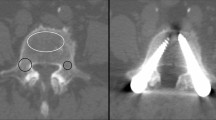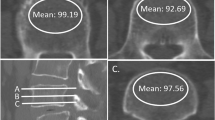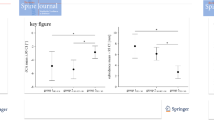Abstract
Purpose
The LLIF procedure is a useful stand-alone and adjunct surgical approach for many spinal conditions. One complication of LLIF is subsidence of the interbody graft into the vertebral bodies, resulting in severe pain, impaired arthrodesis and potentially fracture of the body. Low bone density, as measured by T score on DEXA scanning, has also been postulated to increase the risk of subsidence.
Methods
A retrospective review of prospectively collected data was performed on all patients who underwent LLIF at this institution consisting of 712 levels in 335 patients. Patients with subsidence following LLIF were recorded. We utilized the T score obtained from the femoral neck DEXA scans, which is used to determine overall fracture risk. The T score of patients with subsidence was compared to those without subsidence.
Results
20 of 57 (35 %) patients without subsidence had a DEXA T score between −1.0 and −2.4 consistent osteopenia, one patient (1.8 %) exhibited a T score less than −2.5, consistent with osteoporosis. 13 patients of 23 (57 %) with subsidence exhibited a T score between −1.0 and −2.4, consistent with osteopenia, five (22 %) exhibited a T score of −2.5 or less, consistent with osteoporosis. The mean DEXA T score in patients with subsidence was −1.65 (SD 1.04) compared to −0.45 (SD 0.97) in patients without subsidence (p < 0.01). The area under the receiver operating characteristic curve for patients with a T score of −1.0 or less was 80.1 %.
Conclusions
Patients with DEXA T scores less than −1.0 who undergo stand-alone LLIF are at a much higher risk of developing graft subsidence. Further, they are at an increased risk of requiring additional surgery. In patients with poor bone quality, consideration could be made to supplement the LLIF cage with posterior instrumentation.


Similar content being viewed by others

References
Kim CW (2010) Scientific basis of minimally invasive spine surgery: prevention of multifidus muscle injury during posterior lumbar surgery. Spine (Phila Pa 1976) 35(26 Suppl):S281–S286
McAfee PC, Phillips FM, Andersson G, Buvenenadran A, Kim CW, Lauryssen C et al (2010) Minimally invasive spine surgery. Spine (Phila Pa 1976) 35(26 Suppl):S271–S273
O’Toole JE, Eichholz KM, Fessler RG (2009) Surgical site infection rates after minimally invasive spinal surgery. J Neurosurg Spine 11(4):471–476
Rodgers WB, Gerber EJ, Patterson J (2011) Intraoperative and early postoperative complications in extreme lateral interbody fusion: an analysis of 600 cases. Spine (Phila Pa 1976) 36:26–32
Ozgur BM, Aryan HE, Pimenta L, Taylor WR (2006) Extreme lateral interbody fusion (XLIF): a novel surgical technique for anterior lumbar interbody fusion. Spine J 6(4):435
Tempel ZJ, Gandhoke GS, Bonfield CM, Okonkwo DO, Kanter AS (2014) Radiographic and clinical outcomes following combined lateral lumbar interbody fusion and posterior segmental stabilization in patients with adult degenerative scoliosis. Neurosurg Focus 36(5):E11
Karikari IO, Nimjee SM, Hardin CA, Hughes BD, Hodges TR, Mehta AI et al (2011) Extreme lateral interbody fusion approach for isolated thoracic and thoracolumbar spine diseases: initial clinical experience and early outcomes. J Spinal Disord Tech 24:368–375
Marchi L, Abdala N, Oliveira L, Amaral R, Coutinho E, Pimenta L (2012) Stand-alone lateral interbody fusion for the treatment of low-grade degenerative spondylolisthesis. Sci World J 2012:456346
Marchi L, Oliveira L, Amaral R, Castro C, Coutinho T, Coutinho E et al (2012) Lateral interbody fusion for treatment of discogenic low back pain: minimally invasive surgical techniques. Adv Orthop 2012:282068
Pimenta L, Oliveira L, Schaffa T, Coutinho E, Marchi L (2011) Lumbar total disc replacement from an extreme lateral approach: clinical experience with a minimum of 2 years’ follow-up. Clinical article. J Neurosurg Spine 14:38–45
Formica M, Berjano P, Cavagnaro L, Zanirato A, Piazzolla A, Formica C (2014) Extreme lateral approach to the spine in degenerative and post traumatic lumbar diseases: selection process, results and complications. Eur Spine J 23(6 Suppl):S684–S692
Berjano P, Balsano M, Buric J, Petruzzi M, Lamartina C (2012) Direct lateral access lumbar and thoracolumbar fusion: preliminary results. Eur Spine J 21(1 Suppl):S37–S42
Berjano P, Lamartina C (2013) Far lateral approaches (XLIF) in adult scoliosis. Eur Spine J 22(2 Suppl):S242–S253
Costanzo G, Zoccali C, Maykowski P, Walter CM, Skoch J, Baaj AA (2014) The role of minimally invasive lateral lumbar interbody fusion in sagittal balance correction and spinal deformity. Eur Spine J 23(6 Suppl):S699–S704
Tormenti MJ, Maserati MB, Bonfield CM, Okonkwo DO, Kanter AS (2010) Complications and radiographic correction in adult scoliosis following combined transpsoas extreme lateral interbody fusion and posterior pedicle screw instrumentation. Neurosurg Focus 28(3):E7
Anand N, Rosemann R, Khalsa B, Baron EM (2010) Mid-term to long-term clinical and functional outcomes of minimally invasive correction and fusion for adults with scoliosis. Neurosurg Focus 28(3):E6
Caputo AM, Michael KW, Chapman TM Jr, Massey GM, Howes CR, Isaacs RE et al (2012) Clinical outcomes of extreme lateral interbody fusion in the treatment of adult degenerative scoliosis. Sci World J 2012:680643
Isaacs RE, Hyde J, Goodrich JA, Rodgers WB, Phillips FM (2010) A prospective, nonrandomized, multicenter evaluation of extreme lateral interbody fusion for the treatment of adult degenerative scoliosis: perioperative outcomes and complications. Spine (Phila Pa 1976) 35(26 Suppl):S322–S330
Sharma AK, Kepler CK, Girardi FP, Cammisa FP, Huang RC, Sama AA (2011) Lateral lumbar interbody fusion: clinical and radiographic outcomes at 1 year: a preliminary report. J Spinal Disord Tech 24:242–250
Moller DJ, Slimack NP, Acosta FL Jr, Koski TR, Fessler RG, Liu JC (2011) Minimally invasive lateral lumbar interbody fusion and transpsoas approach-related morbidity. Neurosurg Focus 31:E4
Rodgers WB, Cox CS, Gerber EJ (2010) Early complications of extreme lateral interbody fusion in the obese. J Spinal Disord Tech 23:393–397
Dua K, Kepler CK, Huang RC, Marchenko A (2010) Vertebral body fracture after anterolateral instrumentation and interbody fusion in two osteoporotic patients. Spine J 10:E11–E15
Brier-Jones JE, Palmer DK, Inceoglu S, Cheng WK (2011) Vertebral body fractures after transpsoas interbody fusion procedures. Spine J 11:1068–1072
Le TV, Baaj AA, Dakwar E, Burkett CJ, Murray G, Smith DA, Uribe JS (2012) Subsidence of polyetheretherketone intervertebral cages in minimally invasive lateral retroperitoneal transpsoas lumbar interbody fusion. Spine (Phila Pa 1976) 37(14):1268–1273
Marchi L, Abdala N, Oliveira L, Amaral R, Coutinho E, Pimenta L (2013) Radiographic and clinical evaluation of cage subsidence after stand-alone lateral interbody fusion. J Neurosurg Spine 19(1):110–118
Le TV, Smith DA, Greenberg MS, Dakwar E, Baaj AA, Uribe JS (2012) Complications of lateral plating in the minimally invasive lateral transpsoas approach. J Neurosurg Spine 16:302–307
Blake GM, Fogelman I (2007) The role of DXA bone density scans in the diagnosis and treatment of osteoporosis. Postgrad Med J 83:509–517
Marshall D, Johnell O, Wedel H (1996) Meta-analysis of how well measures of bone mineral density predict occurrence of osteoporotic fractures. BMJ 312(7041):1254–1259
Stone KL, Seeley DG, Lui LY, Cauley JA, Ensrud K, Browner WS, Osteoporotic Fractures Research Group et al (2003) BMD at multiple sites and risk of fracture of multiple types: long-term results from the Study of Osteoporotic Fractures. J Bone Miner Res 18(11):1947–1954
Johnell O, Kanis JA, Oden A, Johansson H, De Laet C, Delmas P et al (2005) Predictive value of BMD for hip and other fractures. J Bone Miner Res 20(7):1185–1194
Wright NC, Looker AC, Saag KG, Curtis JR, Delzell ES, Randall S et al (2014) The recent prevalence of osteoporosis and low bone mass in the United States based on bone mineral density at the femoral neck or lumbar spine. J Bone Miner Res 29(11):2520–2526
Chin DK, Park JY, Yoon YS, Kuh SU, Jin BH, Kim KS et al (2007) Prevalence of osteoporosis in patients requiring spine surgery: incidence and significance of osteoporosis in spine disease. Osteoporos Int 18(9):1219–1224
Tu CW, Huang KF, Hsu HT, Li HY, Yang SS, Chen YC (2014) Zoledronic acid infusion for lumbar interbody fusion in osteoporosis. J Surg Res 192(1):112–116
Ohtori S, Inoue G, Orita S, Yamauchi K, Eguchi Y, Ochiai N et al (2013) Comparison of teriparatide and bisphosphonate treatment to reduce pedicle screw loosening after lumbar spinal fusion surgery in postmenopausal women with osteoporosis from a bone quality perspective. Spine (Phila Pa 1976) 38:E487–E492
Conflict of interest
Dr. Kanter receives royalties from Lanx.
Author information
Authors and Affiliations
Corresponding author
Rights and permissions
About this article
Cite this article
Tempel, Z.J., Gandhoke, G.S., Okonkwo, D.O. et al. Impaired bone mineral density as a predictor of graft subsidence following minimally invasive transpsoas lateral lumbar interbody fusion. Eur Spine J 24 (Suppl 3), 414–419 (2015). https://doi.org/10.1007/s00586-015-3844-y
Received:
Revised:
Accepted:
Published:
Issue Date:
DOI: https://doi.org/10.1007/s00586-015-3844-y



